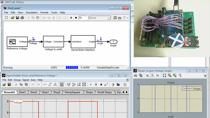How to Create Compositions in System Composer
Sketch hierarchical system and software decompositions of components using a familiar component, port, and connector modeling approach. Iteratively add more details to your design until you are ready for implementation in Simulink®.
Published: 22 Feb 2019
The main view in System Composer is the composition view. It contains all the components in your architecture model that will eventually be implemented. You can think of it as a bill of materials view.
It consists of 3 base graphical items.
Components, which are boxes. Localization and Motor are two components in this composition.
Components have ports. These can be either input ports or output ports. Think of them as doorways that allow information to flow in or out of a component.
R1 is an input port R2 is an output port for localization. Notice they are both on the same side of the component. Ports can be placed on any side of a component, even top and bottom.
Components can be further decomposed. The content preview shows that the obstacle Avoidance component has been further decomposed.
The ports on the Obstacle Avoidance boundary are the same as the ones in level above and are connected to ports of the components seen here such as Path Planning.
Let’s create a new component, port and connector.
Drag out a box to create a component and give it a name. In this case Mag Sensor.
Now click on the component boundary to add a port and drag a line to connect it to another port then give the port a name.
This is a hierarchal composition diagram consisting of components, ports and connectors.




